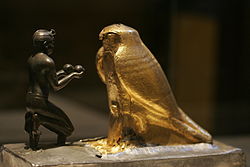This article's lead section may be too short to adequately summarize the key points. Please consider expanding the lead to provide an accessible overview of all important aspects of the article. (December 2021)
| Hemen | |
|---|---|
 | |
| Symbol | Falcon |
Hemen is a falcon god in the Ancient Egyptian religion
Places of worship
[edit]
Often worshipped as a divine entity unified with Horus, as Horus-Hemen lord of Asphynis[1] or Horakhte-Hemen of Hefat.[2][3][4] Flinders Petrie refers to Hemen as a god of Tuphium. Hemen is also used for the name of a town of ancient Egypt (as mentioned by Flinders Petrie during his studies of Abydos).[5]
Some examples of artifacts containing references to Hemen
[edit]Hemen is mentioned in a limited number of inscriptions and texts. Some of these include:
- In the Pyramid Texts, Utterance 231.[6]
- Ankhtifi, a nomarch (= provincial governor) dated to the First Intermediate Period, is shown inspecting a fleet, killing a hippopotamus in Hefat during festivities and offering the hippopotamus to Hemen.[7]
- A round-topped stela from the 13th dynasty invokes Ptah-Sokari-Osiris and Horus-Hemen lord of Asphynis. The stela was formerly in the V. Golenishchev collection, but is now in Moscow, in the State Pushkin Museum of Fine Arts.[8]
- The chief sculptor Userhat who lived at the end of the 18th dynasty/beginning 19th dynasty mentions "causing cult statues to rest in their shrine". Hemen of Hefat is one of the gods listed among those Userhat was responsible for.[9]
- Statue from the time of Amenhotep III; Now in Avignon, Musée Calvet.[10][11]
- In the 22nd dynasty Hemen of Hefat is mentioned as an oracle. A man named Ikeni appears before Hemen in Hefat and the god says "Ikeni is right! He paid (etc.)".[12]
- The 25th dynasty pharaoh Taharqa is shown before the god Hemen in a statue which is now in the Louvre.
- In ca. 300 BC Hemen's cult is still active as attested by an inscription of an official named Hornefer.[2]
- In the Griffiths Institute listing: A stone object with Hemen possibly hawk-headed showing text of Amenophis III ‘beloved of Hemen lord of the sed-festival’.[13]
See also
[edit]References
[edit]- ^ The Griffiths Institute
- ^ a b "Text of Hor-nefer". Archived from the original on 2012-03-03. Retrieved 2010-04-29.
- ^ The Griffiths Institute formerly in V. Golenishchev colln. 4157, now in Moscow, State Pushkin Museum of Fine Arts
- ^ Henri Wild, Statue de Hor-Néfer au Musée des Beaux-Arts de Lausanne, BIFAO 54 (1954) pp.173-222 via Text of Hornefer Archived 2012-03-03 at the Wayback Machine
- ^ Mentioned in Jean Capart, Primitive art in Egypt , 1905, accessed at Primitive Art in Egypt retrieved 12/09/2011
- ^ "Pyramid Texts Online - English Translation".
- ^ J.M.A. Janssen, Annual Egyptological Bibliography, 1947
- ^ Griffith Institute working document on Stela, page 208. retrieved 20/09/2011
- ^ Elizabeth Frood, John Baines, Biographical texts from Ramessid Egypt, 2007
- ^ location (listed 14th on page)Statues of Deities), Oxford: Griffith Institute, 1999 Archived 2011-07-25 at the Wayback Machine ISBN 0-900416-69-6 retrieved 20/09/2011
- ^ (with D. Magee and E. Miles) Topographical Bibliography of Ancient Egyptian Hieroglyphic Texts, Statues, Reliefs and Paintings, viii, Objects of Provenance Not Known, Part 2. Private Statues (Dynasty XVIII to the Roman Period). Statues of Deities. Oxford: Griffith Institute. 1999. ISBN 0-900416-69-6 description of statue from page 1041 of Griffiths Institute of Oxford retrieved 20/09/2011
- ^ Kim Ryholt, A Pair of Oracle Petitions Addressed to Horus-of-the-Camp, The Journal of Egyptian Archaeology, Vol. 79 (1993), pp. 189-198
- ^ (with D. Magee and E. Miles) Topographical Bibliography of Ancient Egyptian Hieroglyphic Texts, Statues, Reliefs and Paintings, viii, Objects of Provenance Not Known, Part 2. Private Statues (Dynasty XVIII to the Roman Period). Statues of Deities. Oxford: Griffith Institute. 1999. ISBN 0-900416-69-6 description of statue from page 1041 of Griffiths Institute of Oxford retrieved 20/09/2011
Further reading
[edit]- "Crime, Cult and Capital Punishment (Mo'alla Inscription 8)" by H. Willems, The Journal of Egyptian Archaeology Vol. 76, (1990), pp. 27–54, Retrieved 11 April 2015, (subscription required)
| Beliefs | |||||
|---|---|---|---|---|---|
| Practices | |||||
| Deities |
| ||||
| Cultures | |||||
| Locations | |||||
| Sacred animals | |||||
| Symbols and objects |
| ||||
| Languages | |||||

